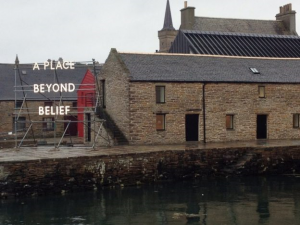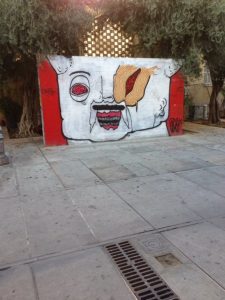26 June 2018 Just out of reach: magic, opacity, and unknowability
“But what do you mean by magic?” There’s a long pause in the conversation; the anthropologist wonders whether they’ve asked the wrong question. “Well I suppose I mean… well, magic… like Eynhallow.” To those familiar with Orkney, this small ‘holy island’ is rich in stories: once upon a time a coming-and-going island, rising from the sea only to disappear, until it was won over from the shape-shifting finfolk by the use of holy salt. Still the island retains an uncanny quality: in 1990 two people were said to have disappeared into thin air after 88 were counted off an excursion ferry to the uninhabited island and only 86 were counted back on. Keep reading here…
28 March 2018 Anti-authoritarian unbelief: or, not being told what (not) to believe
Walking through the old town of Nicosia, perched between two olive trees, Theo encountered graffiti of a snarling creature with red eyes in the grounds of a church. Besides the illegible signature of the artist there is no text accompanying the image, but the demonic imagery and its strategic placement – directly facing the north façade of the church – leaves little room for interpretation. Surely this is an act of resistance and opposition to the yellow limestone and hagiographies of the aging building?
Such imagery serves as a background to the everyday discourse of unbelief, especially among the youth of the city. But why would non-believers revel in such apparently occult imagery? This might seem contradictory, given that unbelievers, by their very nature, are thought to tend towards rationalism as a set of logical ideas and assumptions about the world. Keep reading here…
26 October 2017 Understanding Unbelief – understanding what?

A place beyond belief by Nathan Coley. Photo Pier Arts Centre, Stromness, Orkney.
In 2013, Nathan Coley’s art installation “A place beyond belief” was brought to Orkney’s shore. The words provoke: what does it mean to be a place beyond belief? One interpretation, enhanced by the juxtaposition of the sign with spire of the redundant church behind it (now Stromness’ Town Hall), is that here is place where church membership, and apparently the relevance of religious belief itself, has declined dramatically. As Steve Bruce has outlined in his book Scottish Gods, the story of the Scottish islands, in keeping with the rest of the UK, has been one of increasing disengagement from organised religion; non-belief emerging as the norm. In this sense, it is becoming a place beyond belief. Yet for those who described the sculpture in its Orkney setting, another interpretation presented itself: here was a place of wonder, a place beyond our limited capacity for belief. A magical place, even. Keep reading here…
